

Gallica, Bibliotheque nationale de France digital library. Louis_Pasteur. Louis Pasteur (/ˈluːi pæˈstɜr/, French: [lwi pastœʁ]; December 27, 1822 – September 28, 1895) was a French chemist and microbiologist renowned for his discoveries of the principles of vaccination, microbial fermentation and pasteurization.
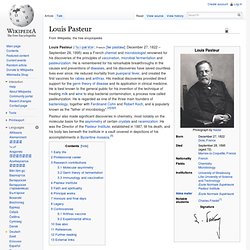
He is remembered for his remarkable breakthroughs in the causes and preventions of diseases, and his discoveries have saved countless lives ever since. He reduced mortality from puerperal fever, and created the first vaccines for rabies and anthrax. His medical discoveries provided direct support for the germ theory of disease and its application in clinical medicine. He is best known to the general public for his invention of the technique of treating milk and wine to stop bacterial contamination, a process now called pasteurization.
Rudolf Virchow. Rudolf Ludwig Karl Virchow (13 de octubre de 1821, Schivelbein, Pomerania, Prusia - 5 de septiembre de 1902, Berlín) fue un médico y político alemán.
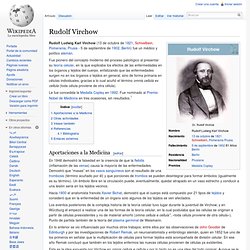
Fue pionero del concepto moderno del proceso patológico al presentar su teoría celular, en la que explicaba los efectos de las enfermedades en los órganos y tejidos del cuerpo, enfatizando que las enfermedades surgen no en los órganos o tejidos en general, sino de forma primaria en células individuales, gracias a lo cual acuñó el término omnis cellula ex cellula (toda célula proviene de otra célula). Le fue concedida la Medalla Copley en 1892. Fue nominado al Premio Nobel de Medicina en tres ocasiones, sin resultados.[1] Aportaciones a la Medicina[editar] En 1848 demostró la falsedad en la creencia de que la flebitis (inflamación de las venas) causa la mayoría de las enfermedades. Esta es la idea expuesta por Virchow en omnis cellula e cellula y por lo tanto no es una idea del todo original.
Lp_publi.htm. Augustin-Jean_Fresnel. Augustin-Jean Fresnel (/freɪˈnɛl/ fray-NEL; French: [ɔ.ɡy.stɛ̃ ʒɑ̃ fʁɛ.nɛl]; 1788–1827), was a French engineer and physicist who contributed significantly to the establishment of the theory of wave optics.
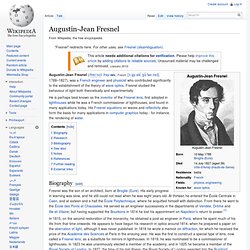
Fresnel studied the behaviour of light both theoretically and experimentally. He is perhaps best known as the inventor of the Fresnel lens, first adopted in lighthouses while he was a French commissioner of lighthouses, and found in many applications today. His Fresnel equations on waves and reflectivity also form the basis for many applications in computer graphics today - for instance, the rendering of water. Biography[edit] Fresnel was the son of an architect, born at Broglie (Eure). Etienne-Louis_Malus.
Malus was born in Paris, France.
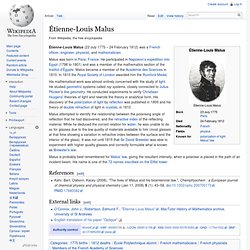
He participated in Napoleon's expedition into Egypt (1798 to 1801) and was a member of the mathematics section of the Institut d'Égypte. Malus became a member of the Académie des Sciences in 1810. In 1810 the Royal Society of London awarded him the Rumford Medal. Malus attempted to identify the relationship between the polarising angle of reflection that he had discovered, and the refractive index of the reflecting material.
While he deduced the correct relation for water, he was unable to do so for glasses due to the low quality of materials available to him (most glasses at that time showing a variation in refractive index between the surface and the interior of the glass). Malus is probably best remembered for Malus' law, giving the resultant intensity, when a polariser is placed in the path of an incident beam. Fran%C3%A7ois_Arago. François Jean Dominique Arago (Catalan: Francesc Joan Domènec Aragó), known simply as François Arago (French: [fʁɑ̃swa aʁaɡo]; Catalan: Francesc Aragó, IPA: [fɾənˈsɛsk əɾəˈɣo]) (1786–1853), was a French mathematician, physicist, astronomer, freemason,[2] carbonari[3] and politician.
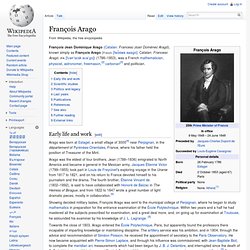
Early life and work[edit] Arago was born at Estagel, a small village of 3000[4] near Perpignan, in the département of Pyrénées-Orientales, France, where his father held the position of Treasurer of the Mint. Arago was the eldest of four brothers. Jean (1788–1836) emigrated to North America and became a general in the Mexican army. Jacques Étienne Victor (1799–1855) took part in Louis de Freycinet's exploring voyage in the Uranie from 1817 to 1821, and on his return to France devoted himself to his journalism and the drama. Jean-Baptiste_Biot. Biography[edit] Jean-Baptiste Biot was born in Paris, France on 21 April 1774 and died in Paris on 3 February 1862.
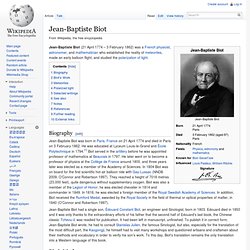
He was educated at Lyceum Louis-le-Grand and École Polytechnique in 1794.[1] Biot served in the artillery before he was appointed professor of mathematics at Beauvais in 1797. He later went on to become a professor of physics at the Collège de France around 1800, and three years later was elected as a member of the Academy of Sciences. In 1804 Biot was on board for the first scientific hot-air balloon ride with Gay-Lussac (NNDB 2009, O’Connor and Robertson 1997). They reached a height of 7016 metres (23,000 feet), quite dangerous without supplementary oxygen. Jean-Baptiste Biot had a single son, Édouard Constant Biot, an engineer and Sinologist, born in 1803.